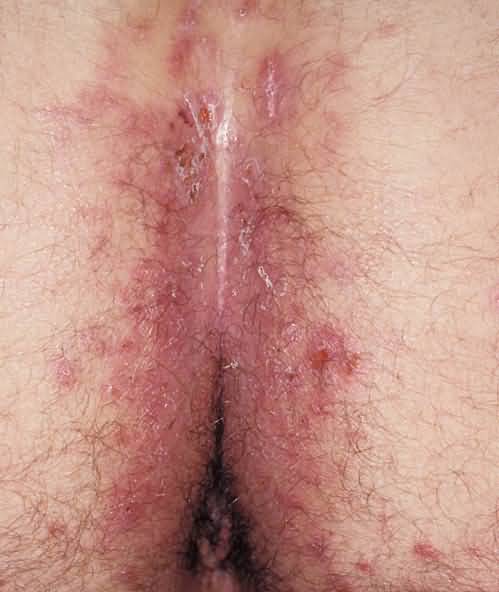Dermatitis Herpetiformis: Definition
An inflammatory process characterized by symmetrical distribution, especially on the skin of the scalp, overlying the scapulae and the sacrum, on the buttocks, and on the extensor surface of the extremities, of clusters of urticarial papules, papulovesicles, and vesicles that are so intensely pruritic that they soon are scratched away, leaving in the wake erosions, ulcers, hemorrhagic crusts, and eventually pigmented macules and scars.
Dermatitis Herpetiformis: Adjunctive Diagnostic Tests
Demonstration of granular deposits of IgA situated at the tips of dermal papillae in both perilesional and normal-appearing skin. In severe cases, biopsy of the small intestine can be performed for the purpose of identifying celiac-like disease caused by sensitivity to gluten.
Dermatitis Herpetiformis: Course
Dermatitis herpetiformis tends to appear in young adults, but it may develop in children and in the elderly, usually as urticarial papules and vesicles that are clustered in bilateral symmetrical fashion especially on the scalp, scapulae, extensor surface of arms and legs (in particular the region of the elbows and knees), sacrum, and buttocks. The lesions wax and wane, and in the absence of specific therapy, tend to come and go for a lifetime. Episodically, and exceptionally, the disease remits, not to reappear.
Dermatitis Herpetiformis: Integration: Unifying Concept
Dermatitis herpetiformis is a distinctive pathologic process that manifests itself as urticarial papules and vesicles; these lesions have a predilection for certain anatomic sites. Papules are made up mostly of neutrophils in edematous dermal papillae and in subepidermal clefts, and subepidermal vesicles also contain neutrophils. Neutrophils are joined by eosinophils within two or three days after a lesion first appears. The disease is thought to be autoimmune in nature, granular deposits of IgA alone or in combination with C3 being present at tips of dermal papillae.
Although the cause and mechanism of dermatitis herpetiformis are not known, it is thought currently that deposits of IgA in the papillary dermis are related to hypersensitivity to gluten. Ingestion of gluten is thought to initiate formation of IgA antibodies in the gastrointestinal tract, circulation of those antibodies, attachment of them to cutaneous structures, activation of complement, chemotaxis of neutrophils, and development of subepidermal blisters. The process is believed to be a consequence of the effects of products released by neutrophils on the attachment of the epidermis to the dermis. A gluten-sensitive enteropathy resembling celiac disease is commonly associated with dermatitis herpetiformis.
The findings histopathologic in linear IgA dermatosis are identical to those in dermatitis herpetiformis, but the aspects clinical and attributes immunologic of those diseases are different from one another.
Linear IgA Dermatosis: Adjunctive Diagnostic Test v
Direct immunofluorescence test to demonstrate linear deposits of IgA at the basement membrane.
Linear IgA Dermatosis: Course
The fundamental lesions of linear IgA dermatosis are urticarial papules, vesicles, and bullae, some of which may be large. The individual papules tend to last for no more than several weeks, and the vesicles and bullae even more briefly. Papules resolve without residua, whereas vesicles and bullae involute with crusts before healing as hyperpigmented or hypopigmented macules and patches. The disease itself is characterized by remissions and exacerbations, but may go on for years.
Linear IgA Dermatosis: Integration: Unifying Concept
Findings histopathologic in papules and blisters of linear IgA dermatosis, in times past known as bullous dermatosis of childhood, are indistinguishable from those of dermatitis herpetiformis. Neutrophils are present in collections in dermal papillae and in subepidermal spaces, as well as in subepidermal blisters. Eosinophils follow neutrophils into the upper part of the dermis and into subepidermal blisters. Although linear deposits of IgA are discernible at the basement membrane zone of both dermatitis herpetiformis and linear IgA dermatosis, the deposits are granular in the former and linear in the latter. The cause of linear IgA dermatosis, like that of dermatitis herpetiformis, is not known.
Linear IgA Dermatosis: Therapy
Dapsone is the treatment of choice. An alternative method is a combination of systemic corticosteroids and an immunosuppressant such as azathioprine.



